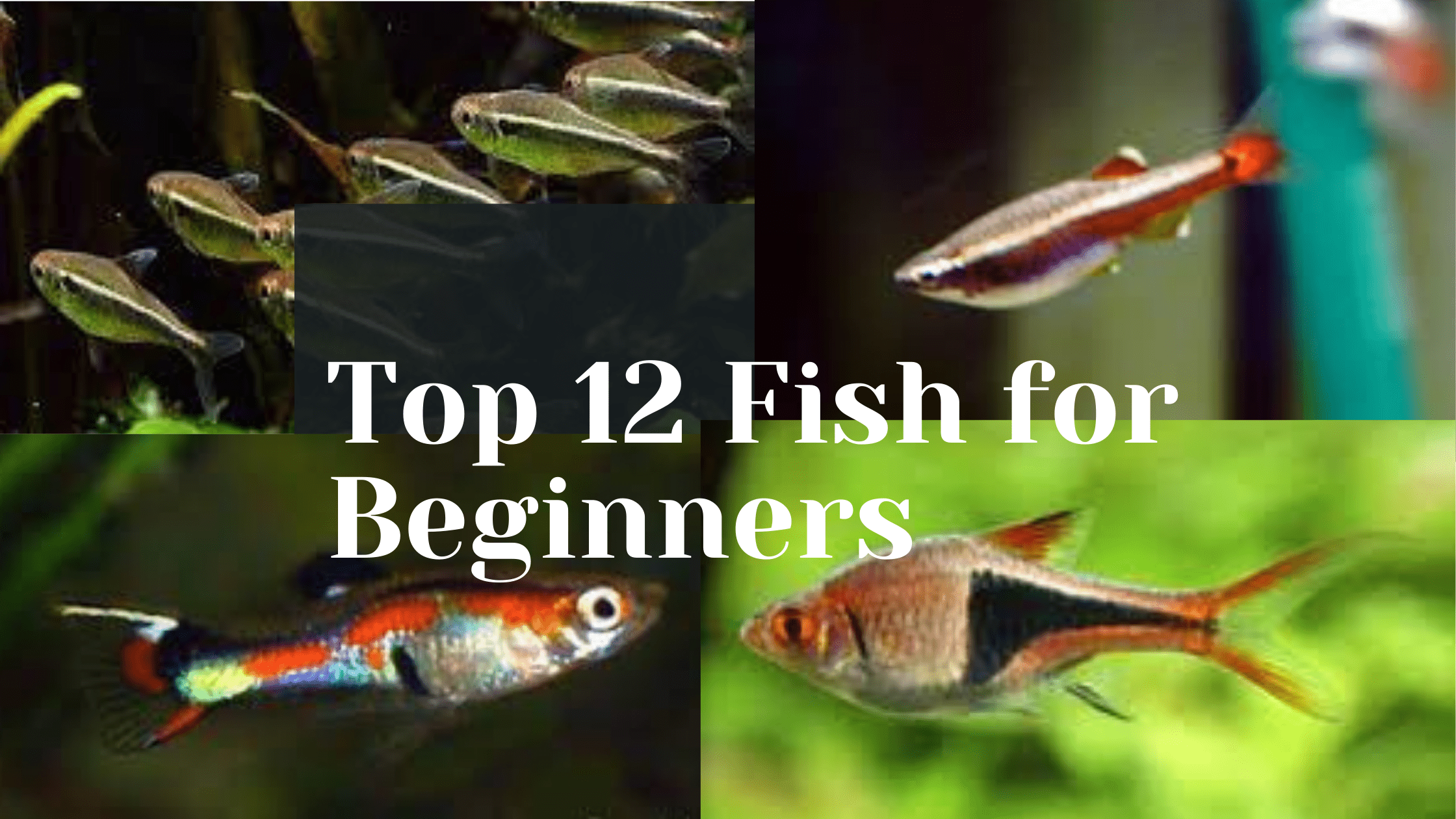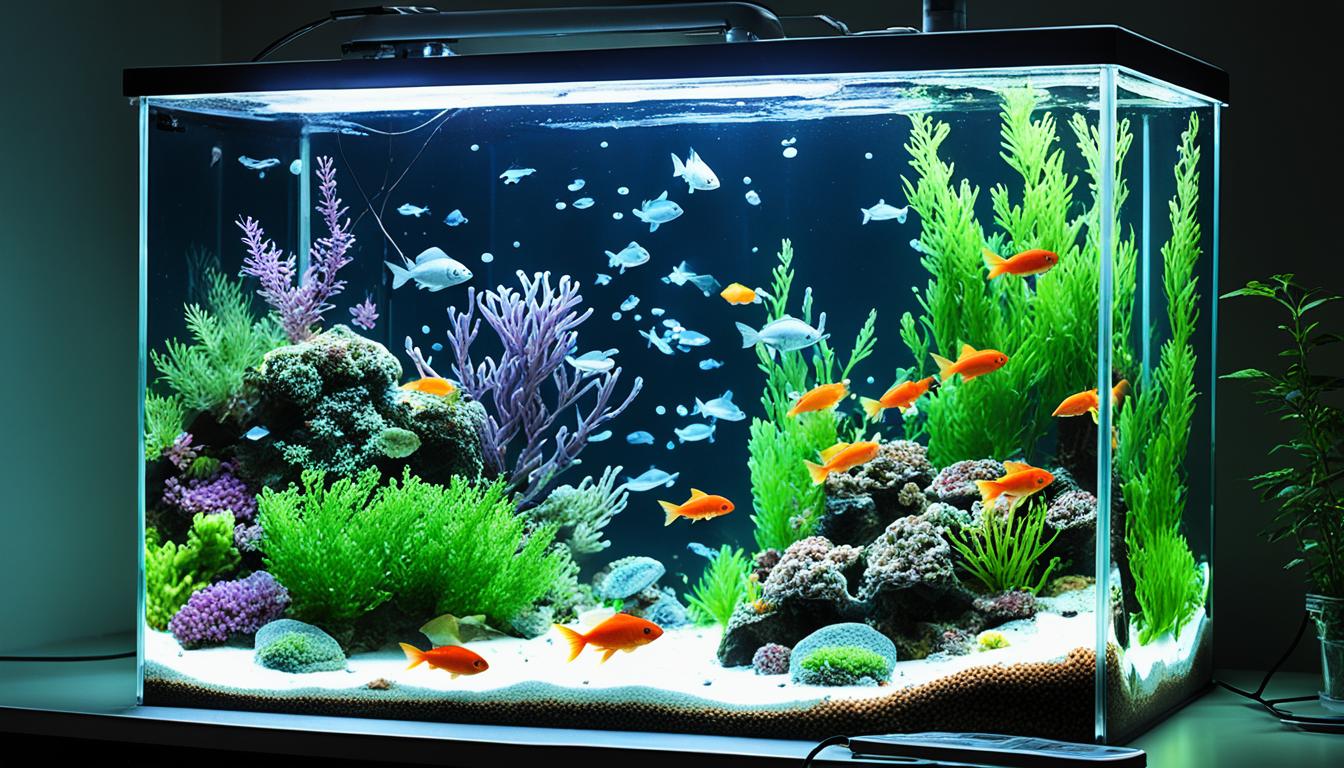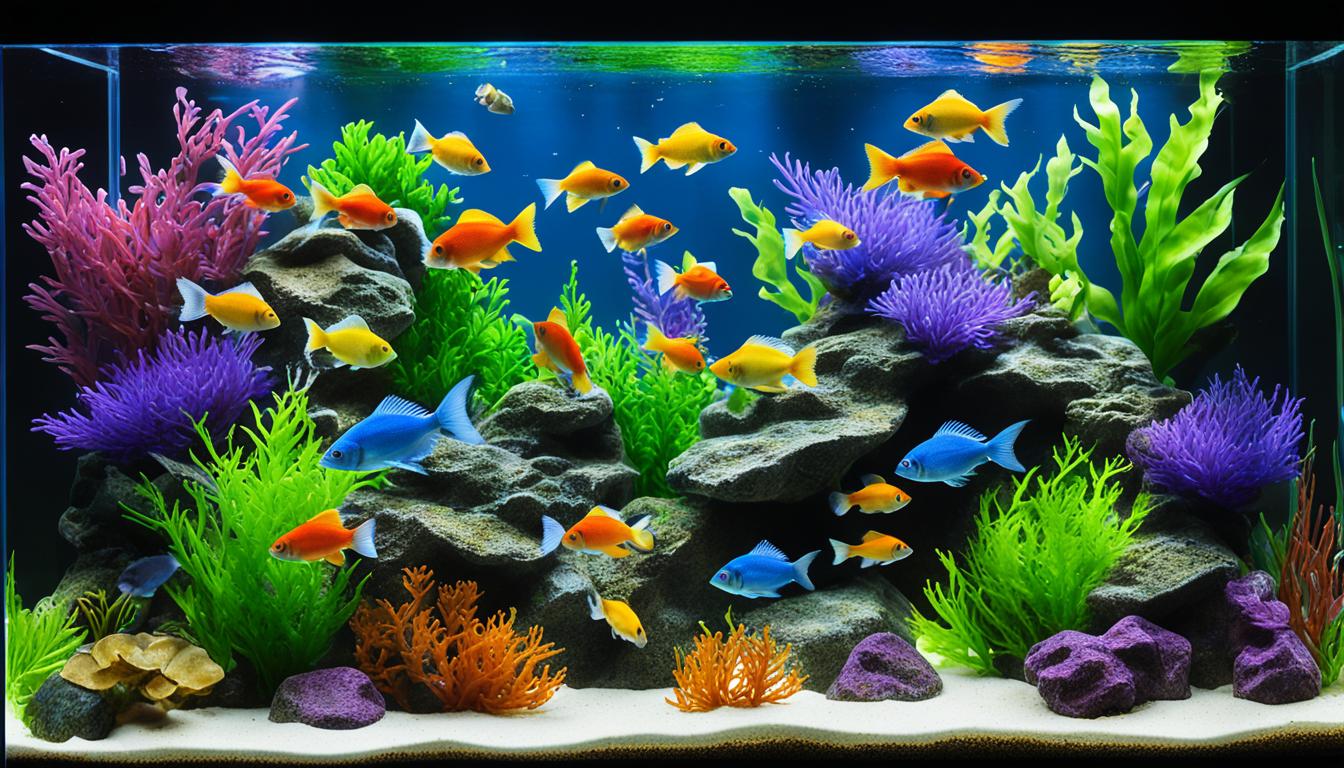Table of Contents
Introduction:
Freshwater aquariums are the perfect way to start with the hobby of fishkeeping. They are low-maintenance and generally less expensive than saltwater tanks. The key to success is choosing the right fish for your tank.
There are many factors that will affect what kind of fish you should get for your freshwater aquarium. You need to take into account what type of water, temperature, and how much space you have available in your tank. However, there are some beginner friendly species of freshwater fish that are ideal for anyone looking to get started with their own freshwater aquarium.
Most of the fish recommended here are good for beginners and for a community-style tank.
Here are some of the top ten best fish for beginners:
Kuhli loach
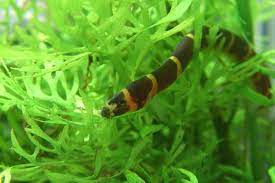
Cooley loach is a bottom dweller it’s goanna hang out down low they’re fairly nocturnal and what that means is they don’t like a whole lot of light, they prefer like low light, more active when the light is dim so if you can dim the light down or turn one of the lights off or something like that when you’re feeding them it makes it a lot easier form they like to hang out at the bottom of caves and rock formations pieces of wood roots of plants any of those things and get a little group or posse of these of three to six they’re good scavengers and so you do need to feed them they don’t get much bigger than about that and they’re cool because they’re lie snakes and since they hide behind plants and burrows into the soil it is difficult to catch them.
They are easy to take care and they live long often times they are one of the last remaining fish if someone’s neglected an aquarium, they can live for 7 or 8 years. They’re hidden most the time they don’t really run into the problem of aggression from other aggressive fish as they stay hidden for most of the times
Bristlenose Plecostomus
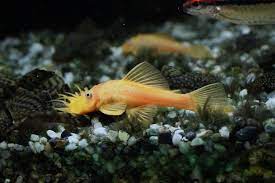
This is my most recommended algae eater or kind of clean-up crew type of fish now I don’t think that every aquarium has to have one but in general everyone ends up owning one, subtle difference I know you can balance an aquarium without needing something to eat algae but most people get one because they look cool it’s a different level they kind of hang out the bottom or up on the glass they’re a sucker fish and lot of people end up buying one once they visit a pet store.
Bristlenose Plecostomus is a great choice they get all these bristles on his face and that’s how you
know it’s a male a female not so much now they do want a little bit of wood in their diet so if you got some driftwood in there that helps I do want some meat in their diet so get them some good quality food and they do want to eat on some algae and they want to eat all the time and again like a Cooley loach they prefer to do that when it’s a little more dim .
The issue you can run into is if you’ve got other bigger fish in there and you dropped the
food in they gobble up all the food and the bristlenose pleco doesn’t get time to eat because they eat slow so they want to eat the food over the hours.
They do take a dedicated effort to be fed they’re highly tolerant of all different types of water parameters temperatures you can keep them with goldfish, you can keep them with tetras, you can keep them with discus.
They really go with this wide span of water parameters or forgiving but they do have a preferred
range and that’s kind of moderate in the middle there of like a pH is 7 to 7 and temperatures a 72 to 80 you know in that span of what’s normal tropical fish community fish temperatures and ranges
they do really well and so that’s goanna allow most people to have success with this fish
Black Neon Tetras
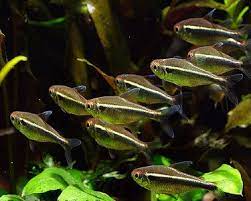
This is a tetra that is always been fairly cheap been very Hardy gets a little bit bigger than neon tetra and they just seem to withstand the new person mistakes and that might be water quality issues or temperature issues. They are nice schooling fish they’re usually 2 or 3 bucks get a get a group of like 6 or more. They look good their schooling around or interact with your live plants. The are quite forgiving fish and is definitely good for a beginner as they require less caring and they adapt well to varying temperature or water parameters.
They aren’t too picky when it comes to eating and things like that and they genuinely transition really well from the fish store to your home aquarium
Harlequin Rasboras
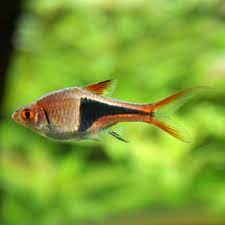
I think it’s because it looks so cool and it’s got the elements of like the black neon tetra where it’s very Hardy it also tends to be a cheaper fish usually under about four dollars now this fish gets about that big the orange can get very intense on the males and it’s got black on there as well and in general it’s a nice schooling fish again kind of six or more on that and as you fall in love with them maybe you go to 12 18 depending on how big your aquarium is but they are readily available at most pet stores.
They are fine with wide variety of water parameters like all the fish on this list we want it to be easy for a beginner.
Albino Corydoras
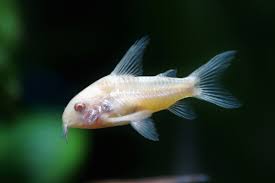
This is another bottom dweller and that is the albino Corydoras and it is yellowy whitish colour, these guys are a schooling catfish or at least a group catfish that lives down low and they get about two and a half inches and cheap so those are good things when it comes to be picking out beginner fish and what their job is to pick up any kind of food leftover from feeding your fish.
They help to keep the gravel clean from any leftover food. They are very easy fish and goes well with all kinds of fish. They are a good tank mate for community fish.
They are very hardy fish and tend to live longer, I have been keeping 3 of them for last 7 years.
It is highly recommended to get yourself six or more if it is a big aquarium but smaller aquarium you can go for 3.
Cherry Barb’s
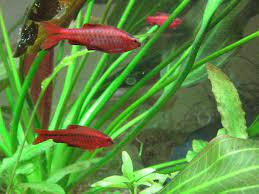
You might have heard Barb’s are aggressive yes some Barb’s are very aggressive the Cherry Barb’s tend to be on the non-aggressive I would say they’re not really any more aggressive than your average tetra or rasboras. The male’s get all this really dark red colour look amazing and then the females get this like oh kind of tannish red and don’t look as amazing but if you don’t have females the male’s won’t look as good too you have a chance that you could breed these in your aquarium you could have a group of six you got three boys three girls.
They are very tolerant of water parameters whether it’s temperature pH or anything they are tolerant and they eat mid water they look really good in a planted tank.
Red eye tetra
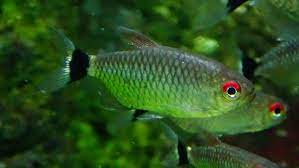
This tetra is a very robust tetra it’s it gets to be a bigger body it gets to be a little bit longer it’s typically a little cheaper it’s not as flashy but this is a great fish to add in you get a group of six or more of these Red eye/ Monk tetras and they’re just goanna school around mostly just eat mid water they’re slightly more fast than your average fish to go and get food but that’s okay they mix in with all the other fish that we’ve recommended and they’re very Hardy and tolerant of wide water parameters and forgiving.
White Cloud Mountain Minnows

There’s a few different varieties and they’re all cool what I want to make sure is you don’t buy feeder white clouds which is used as feeder for other big fish, these raised poorly so dont buy these ones.
The normal white cloud that’s a couple of bucks and it’s about this big and it doesn’t have to have a heater and it can go outside for at least part of the year here it can go around year-round and they can live in small tanks and the male’s say they spar with each other and by sparring this kind of put up their fins like a peacock and but they look super cool to all the other males and girls and you get to witness that makes a great addition to your tank. I wouldn’t put them in if you’re keeping temperatures very hot they don’t like that, they generally prefer cooler temperatures.
They tolerate pH and hardness almost doesn’t matter but when you start getting above about eighty degrees they start running into some illness problems.
Siamese Algae eater

I want to add in another cleaner fish the Siamese algae are not to be confused with the Chinese alligator or the Siamese fighting fish. This is a fish that gets about six inches so you’re going to be a big fish yes it could be a big fish in your aquarium they’re very good at eating hair algae’s and different types of algae’s. When it grows bigger its looks like a shark but it’s goanna help you keep your plants clean keep your glass, wood and substrate clean but it also eats flake food and you know any food you’re goanna put in there.
They are a schooling fish but do they do well in a group so I would recommend to get 3 or more depending on the tank size as they tend to grow fast to 3 or 4 inches.
They tolerate very wide water parameters. They are quite fast and they’ll make sure they get their portion of food so if you got an army of these Siamese algae eaters make sure you’re putting in quite
a bit of food but in general they are really nice for Blackbeard algae’s and hair algae’s. Once they get bigger they tend to eat less algae’s and more fish food. They are generally good algae eaters when they are small in size.
Endlers Livebearers
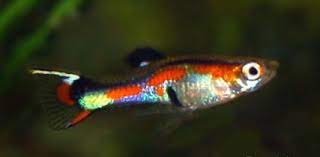
I don’t advise too many different live bearers for new people because they have specific water requirements and they they’re beautiful but can be heavily inbred when it comes to this Endler livebearer it’s a very basic live bear lots of colour in it looks kind of like a wild guppy but because it looks so good in the wild it has never been able to or never needed to be line bred so that we get the
colour and what that means is it’s very adaptable so it can live in PH as low as kind of 6.5 to 7 and higher but there and it can tolerate maybe down to 68 degrees maybe 65 degrees as far as temperature goes and I can go to 80 to 84F.
They keep reproducing and they make a ton so if you’re looking for that I want to make a ton not by very many this is a great fish to do that and it’s forgiving they don’t have giant tails on them to get bacterial infections or anything like that they’re a nimble fish they’re quick so they don’t get picked on by your tetras and other stuff.
Mollys
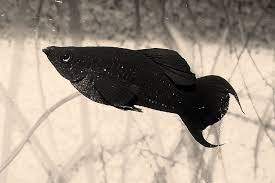
Black Mollys is another live bearer which is very easy keep, it can adapt quickly to different environments. They usually like warm temperatures so if you have cold weather, please do use a heater. Since they are live bearers, they quickly breed and you will quickly have a colony of fishes.
They are good algae eaters so it is also recommended for a planted tank and they are very cheap to buy as well. It is a good beginner fish as it is very hardy.
Guppies
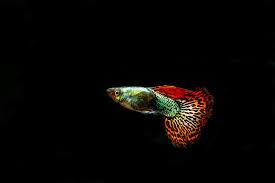
Guppies are very easy to keep but it likes slightly harder water and warmer temperatures. Use a heater if you can cold weather at your place but these are very easy to keep.
They are live bearers so easily breed and you will develop a colony of fishes quickly, if you keep the guppies in a community tank, the breeding will be controlled as other fishes might also eat the small babies so your community of fishes will be on check. They tend to inbred within their group so you might loose the quality of fishes in the long run, in case you have keep the quality of the fishes then it is best to separate males and females and then to do a selective breeding to get the best fishes for your tank.
Conclusion
I have listed only few fishes for beginners but there are lot of fish out there which are good for beginners. I would suggest to start the hobby with few of the above fishes and then experiment with other fishes. Pleas ensure that whenever you are selecting fishes it should be compatible and also temperature and other parameters might be slightly different from one species to another.
If you have some doubts please do reach out to me co*****@*******************le.com
Thanks.
References
- International Federation of Online Clubs and Aquatic Societies (IFOCAS)
- Federation of British Aquatic Societies (FBAS)
- Northeast Council of Aquarium Societies (NEC)
- Federation of American Aquarium Societies (FAAS)
- Marine Aquarium Council (MAC)
- UK Aquatic Plant Society
- International Aquatic Plants Layout Contest (IAPLC)
- ADA – Nature Aquarium
Please check other articles on this website, I have listed some of them here:
Electric Blue Acara: The Ultimate Guide To Care And Keeping
Best Fish for a 40 Gallon Tank: Top Choices for a Thriving Aquarium
Simple Guide to Easy-to-Care-for Aquarium Plants
Discover the Diverse Corydoras Catfish Varieties- A Guide
Get to Know Various Types of Algae Eaters
Master Guide: Best Water Parameters for Goldfish Care 2023-24
Mastering Black Ghost Knife Fish Care: A Comprehensive Guide
Optimal pH Levels for Tropical Fish: Essential Aquarium Guide
Discovering Freshwater Snail Species: An In-depth Guide
Expert Tips for Breeding Guppies: Keys to Successful Fishkeeping
Discover Peaceful Community Fish: Your Guide to Calm Aquatics
Ultimate Guide to Live Food for Betta Fish — Healthy Choices
Complete Guide to Your Perfect Cichlid Tank Setup
Your Guide to the Best Substrate for Planted Aquariums
Essential Guide to Discus Fish Care: Help Your Pets Thrive!
Grow Your Own Eden: Beginner-Friendly Aquascaping Plants Guide
Perfect Neon Tetra Tank Mates: Guide to Aquarium Harmony
Product Review of Eheim Classic vs Professional
The Ultimate Guide to Discus Fish Care
What Fish Can Live With Discus?
Ideal pH for Discus Fish | Aquarium Water Guide
How to Sex Discus Fish?: A Simple Guide for Hobbyists
Complete Discus Fish Tank Setup Guide
Can Discus Fish Live With Angelfish? The Complete Guide
Discus Diet Guide: What Do Discus Fish Eat?
Are Discus Fish Hard to Keep? Insights & Tips.
Optimal Discus Fish Water Parameters Guide
Discus Fish Size Guide 2024: How Big Do Discus Fish Get?
Ultimate Million Fish Guppy Care Guide 2024
Simple Guide to Easy-to-Care-for Aquarium Plants
Grow Your Own Eden: Beginner-Friendly Aquascaping Plants Guide
Hornwort Aquarium Plants: The Ultimate Guide to Care and Maintenance
Aquarium Equipment for Beginners: The Complete Checklist
Feeding Your Aquarium Fish: The Complete Guide
Common Beginner Fishkeeping Mistakes and How to Avoid Them!
Aquarium Plants for Beginners: Easy Care and Beautiful Options
Keeping Your Aquarium Water Clean and Healthy: The Complete Guide
Breeding Aquarium Fish: A Comprehensive Guide
Marine Aquariums: The Ultimate Challenge for Experienced Hobbyists
Tech in the Tank: Must-Have Gadgets for Aquarium Automation
Dwarf Sucking Catfish : The Ultimate Guide to Keeping and Caring for Oto Catfish
The Science of Aquarium Water Chemistry: Understanding pH, KH, and GH
Veiltail Goldfish: The Exquisite Beauty of Flowing Fins
Perfect Neon Tetra Tank Mates: Guide to Aquarium Harmony
Goldfish Care: Beyond the Bowl – Everything You Need to Know
Master Red Tail Shark Care: Tips, Tank Mates & Surprising Traits!
Sheepshead Wrasse Facts & Habitat Guide
Unveiling the Unique Asian Sheepshead Wrasse: A Fascinating Reef Fish with Quirky Behavior
Peacock Wrasse: A Dazzling Addition to Your Aquarium
Vibrant Wrasse Fish: Care Guide & Species Info
Bluestreak Cleaner Wrasse – Vibrant Reef Ally
Coris Wrasse Care Guide for Saltwater Aquariums
Melanurus Wrasse Care Guide & Habitat Tips
I am a passionate aquarist with over 30 years of hands-on experience in fishkeeping. My journey began at a young age, collecting fish from the wild and learning through experimentation. Specializing in tropical fish, I bring a deep understanding of the hobby to FishKeepingMadeSimple. The site provides honest, detailed reviews of essential products and accessories to help fellow enthusiasts create the best environments for their fish.

